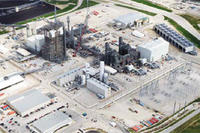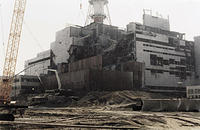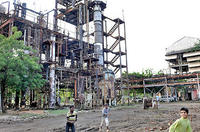-
New insight into improved wave energy testing
Scientists have studied how wave energy developers can more accurately measure and predict the wave conditions within wave energy test sites. The researchers deployed wave measurement buoys and used wave modelling to show how variations in wave size and strength could be resolved.
-
-
Iran becoming serious cyber-warfare threat
Both government and private cybersecurity experts are increasingly considering Iran as a “top ten” cyberthreat. Iran’s recent activities and its motives have led analysts to rank the country among other cyberspace heavy hitters such as Russia and China.
-
-
Ground-improvement methods to protect against earthquakes
Researchers are developing ground-improvement methods to help increase the resilience of homes and low-rise structures built on top of soils prone to liquefaction during strong earthquakes. Findings will help improve the safety of structures in Christchurch and the Canterbury region in New Zealand, which were devastated in 2010 and 2011 by a series of powerful earthquakes.
-
-
Climate change, population pressures leading to rethink of floating cities

The concepts have existed for decades, but governments and financiers, responding to the growing threat of rising tides, pollution, and overpopulation to coastal urban centers, are now beginning to take a more serious look at floating cities.
-
-
Controversial Mississippi power station to cut emissions by more than half

A new $5 billion state-of-the-art power facility is under construction Kemper County, Mississippi. It places a firm bet on the future of carbon-capture technology, and other technological advancements, including: it utilizes the gasification process with carbon in unique ways; it recycles treated wastewater to generate power; and it makes money from the carbon dioxide it has removed by selling it to oil companies for their own extraction. Critics say that investing so much money in untested technologies is too much of a gamble.
-
-
Radiation damage to Chernobyl’s ecosystems helps spread radioactivity

Radiological damage to microbes near the site of the Chernobyl disaster has slowed the decomposition of fallen leaves and other plant matter in the area, according to a new study. The resulting buildup of dry, loose detritus is a wildfire hazard that poses the threat of spreading radioactivity from the Chernobyl area.
-
-
DOE: Contrary to rumor, there are no evacuation plans for southeastern New Mexico
The Department of Energy (DOE) said the other day that an Internet rumor which has been fueling concerns earlier this week about the need to be prepared to evacuate southeastern New Mexico because of recent events at the Waste Isolation Pilot Plant (WIPP) is “absolutely” without basis. DOE notes that monitoring conducted by Nuclear Waste Partnership of air, soil, water, and vegetation are showing no radiation releases that would approach levels causing health concerns.
-
-
Debate over inherently safer technology (IST) at chemical plants intensifies

Recent accidents at chemical facilities around the country have prompt environmental groups and workplace safety advocates to highlight the need for implementing inherently safer technology (IST) at facilities using hazardous chemicals. IST is a methodology or an approach which calls for the adoption of a hierarchy of actions: minimize use of hazardous chemicals, substitute or replace hazardous chemicals with safer ones, moderate or shift to less hazardous chemicals or processes at lower temperatures and pressures, and simplify processes and design plants to eliminate unnecessary complexity.The industry argues that IST is a superficially simple concept but that, in reality, it is rather complex. For example, IST calls for facilities to reduce the amount of materials or chemicals they store on-site, which would increase transportation of the materials or chemicals, thus spreading the risk of chemical accidents to different points along the supply chain.
-
-
Howard County, Md. attracts cybersecurity firms
Howard County, Maryland boasts a growing presence of cybersecurity firms and specialists at a time when the industry is gaining attention. The proximity of the county to government agencies has helped cybersecurity firms gain federal contracts, and the proximity of large cybersecurity consumers like the NSA offers cybersecurity firms in Howard County a large pool of cybersecurity specialists to select from when NSA employees decide to shift to the private sector.
-
-
Computer simulations help predict blast scenarios
Simulation-based engineering science (SBES) allows researchers to predict the effects of building explosions and analyze the response of building materials to those threats. Using a $400,000, five-year CAREER grant from the National Science Foundation, researchers developed the Material Point Method (MPM) a computer-generated tool which not only creates blast scenarios that informs blast and impact resistant materials and design, but also is crossing over into Hollywood animation — most recently, Disney’s Oscar-winning animated film, “Frozen.”
-
-
Planning for future ecological challenges
How can communities dodge future disasters from Mother Nature before she has dealt the blow? Researchers are taking a unique approach to the issue and gaining input and support from community stakeholders. Researchers conducted a series of one-on-one interviews at Big Hole Valley in Montana and Grand County in Colorado to get an array of community contributors thinking and planning for future ecological hazards, and to consider the impact of those decisions.
-
-
International food trade can alleviate water scarcity

International trade of food crops led to freshwater savings worth $2.4 billion in 2005 and had a major impact on local water stress, a new study finds. Trading food involves the trade of virtually embedded water used for production, and the amount of that water depends heavily on the climatic conditions in the production region: It takes, for instance, 2,700 liters of water to produce one kilo of cereals in Morocco, while the same kilo produced in Germany uses up only 520 liters. The researchers found that it is not the amount of water used that counts most, but the origin of the water.
-
-
Shale may offer long-term home for nuclear waste
About 77,000 tons of spent nuclear fuel currently sit in temporary above-ground storage facilities, and it will remain dangerous for tens or hundreds of thousands of years or longer. Experts say that since the U.S. government abandoned plans to develop a long-term nuclear-waste storage site at Yucca Mountain in Nevada in 2009, finding new long-term storage sites must be a priority. Shale deep under the Earth’s surface could be a solution. France, Switzerland, and Belgium already have plans to use shale repositories to store nuclear waste long-term.
-
-
Storm surges, rising sea levels threaten New Jersey’s beach-centered tourism industry
Sea level at the Jersey Shore could rise by thirty-one inches by the year 2050, posing a threat to New Jersey’s $38 billion tourism industry. Experts say that the potential for more harsh storms and sea level rise calls for better promotion of what else New Jersey has to offer tourists aside from the beach.
-
-
NERC drill finds U.S. grid preparedness insufficient
The North American Electric Reliability Corporation (NERC) reported that its recent GridEx II exercise has highlighted the fact that nearly all the utilities which took part in the two-day drill last November – a drill aiming to test the preparedness of the U.S. power grid to withstand cyber and physical attacks – admitted that their planning for such attacks was insufficient. NERC’s president, Gerry Cauley, said that protecting utilities against cyber and physical attacks should be considered in the context of measures taken to protect the grid from other threats. He noted that utilities are already hardening their systems against storms like Hurricane Sandy, while working to determine their vulnerability to solar activity that changes the earth’s magnetic field.
-
More headlines
The long view
Helping Strengthen America’s Critical Infrastructure
Everyday life depends on a robust infrastructure network that provides access to running water, communications technology and electricity, among other basic necessities. The experts who keep our national infrastructure secure and resilient also need a strong network to share their knowledge and train the next generation of professionals capable of solving complex infrastructure challenges.
AI and the Future of the U.S. Electric Grid
Despite its age, the U.S. electric grid remains one of the great workhorses of modern life. Whether it can maintain that performance over the next few years may determine how well the U.S. competes in an AI-driven world.
Using Liquid Air for Grid-Scale Energy Storage
New research finds liquid air energy storage could be the lowest-cost option for ensuring a continuous power supply on a future grid dominated by carbon-free but intermittent sources of electricity.
Enhanced Geothermal Systems: A Promising Source of Round-the-Clock Energy
With its capacity to provide 24/7 power, many are warming up to the prospect of geothermal energy. Scientists are currently working to advance human-made reservoirs in Earth’s deep subsurface to stimulate the activity that exists within natural geothermal systems.
Experts Discuss Geothermal Potential
Geothermal energy harnesses the heat from within Earth—the term comes from the Greek words geo (earth) and therme (heat). It is an energy source that has the potential to power all our energy needs for billions of years.
